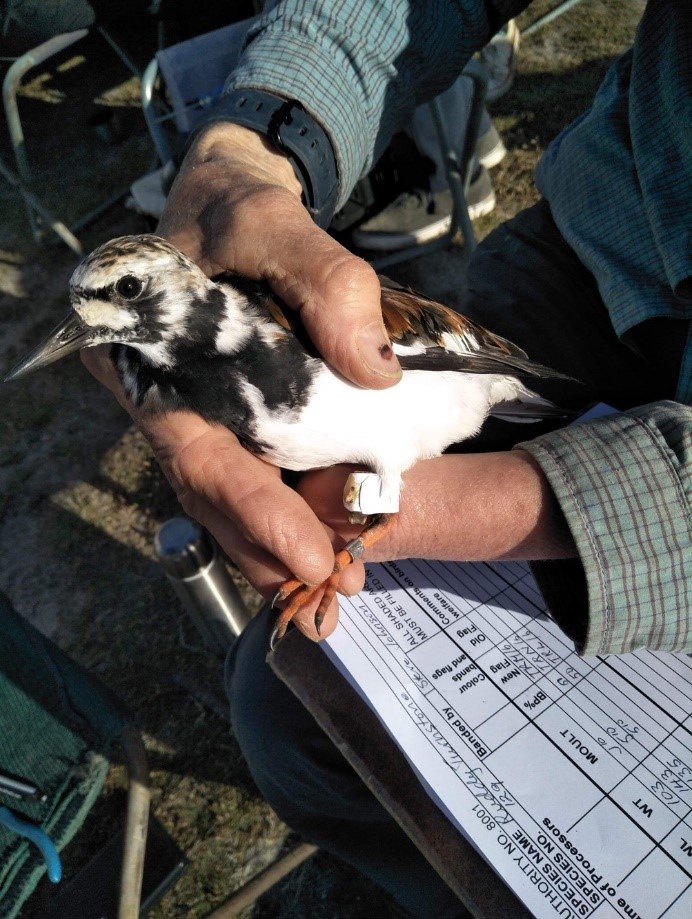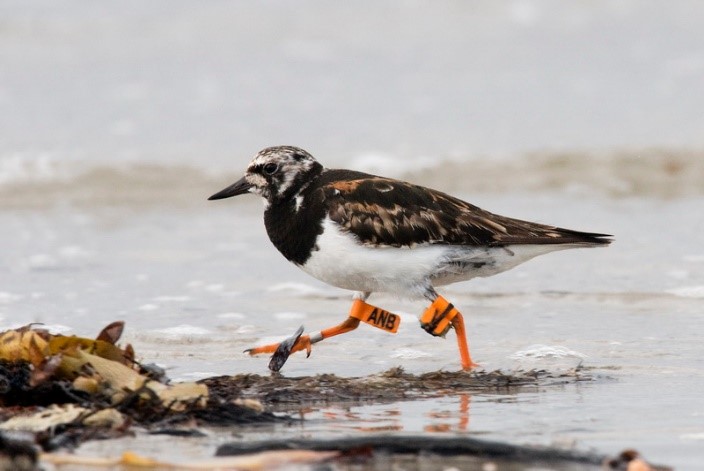Ruddy Turnstone
Ruddy Turnstones are the flagship species for the VWSG geolocator program and constitute the species on which we first placed geolocators. Ruddy Turnstone are medium size shorebirds, generally found on coastlines. In our flyway, these birds spend the non-breeding season here in Australia and NZ, and breed in Siberia. The VWSG has been deploying coloured leg flags on Ruddy Turnstone since 1990 and band sighting records have shown that birds were observed in Taiwan, Hong Kong, Japan and the Yellow Sea.
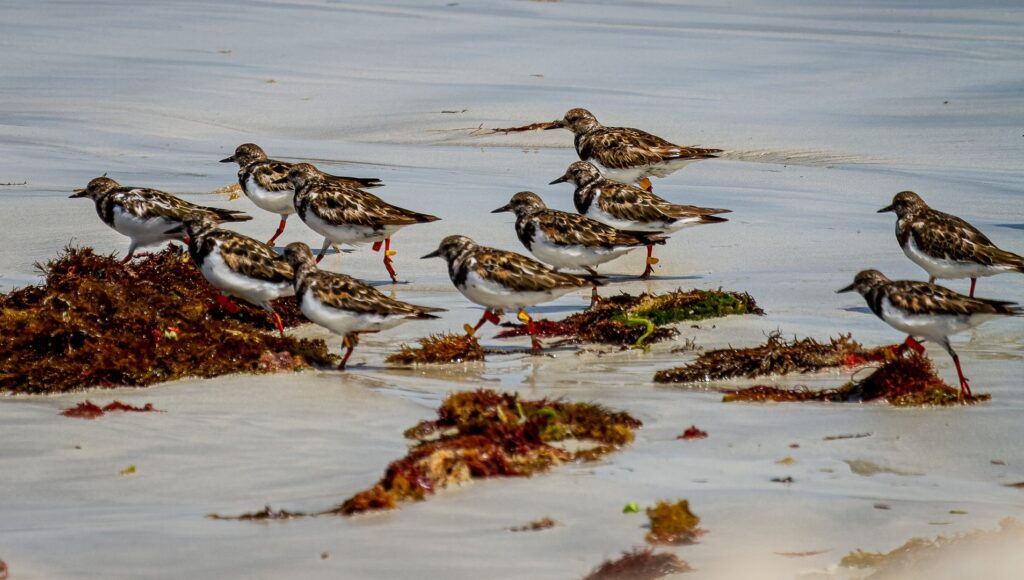
The first geolocator trial included fitting 6 individuals captured at Flinders Beach (Victoria), which delivered several surprising results. The current VWSG program focusses on Ruddy Turnstones captured in the southeast of South Australia (in collaboration with Friends of Shorebirds SE) and King Island (Tasmania). These birds are site-faithful, in that we catch and/or see the same individuals on the same beaches year after year. The VWSG has deployed approximately 700 geolocators and retrieved almost 300 up to mid 2021 providing a 43% retrieval rate. The King Island study site has contributed to a longitudinal study spanning 10 years to date which allows us to assess changing migratory behaviour over time, in the face of the changes along their flyway including climate change.
The geolocator studies have revealed that Ruddy Turnstones from King Island typically fly to Siberia in a number of legs. The typical first leg of 7,500km non-stop flight to Hainan or Taiwan where they refuel before moving up the East China coast before flying the final leg to the breeding grounds in northern Siberia. After returning to King Island, their total round trip has covered 27,000km. Some Ruddy Turnstones use alternate route, such as 9Y that set off from Flinders (Vic) and returned via the Pacific on two consecutive years.
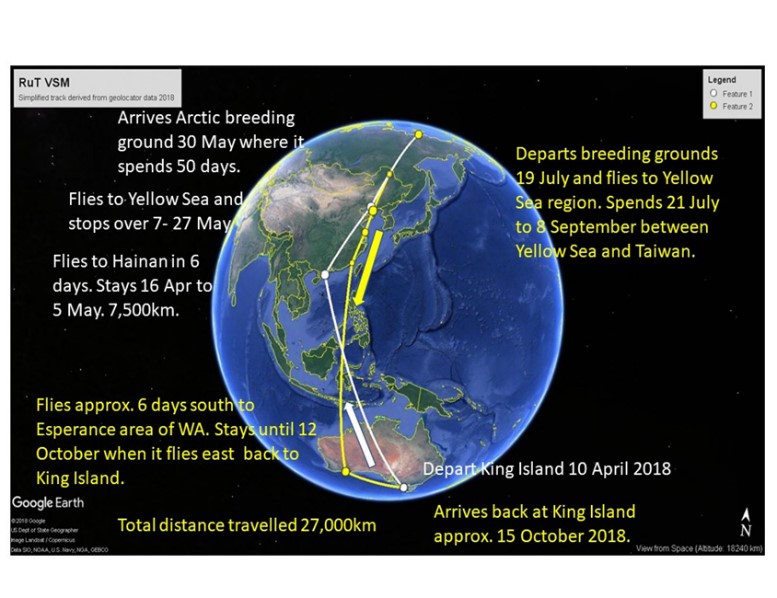
Using updated statistical techniques (Lisovski S, Bauer S, Briedis M, et al. Light‐level geolocator analyses: A user’s guide. J Anim Ecol.2019;00:1–16) have revealed that Ruddy Turnstones breed on the New Siberian Islands and northern Siberia. Most birds arrive in May and spend approximately 50 days during which time they find mates, lay eggs and raise chicks. Adult turnstones depart before their offspring, juveniles thus flying to Australia for the first time without any guidance.
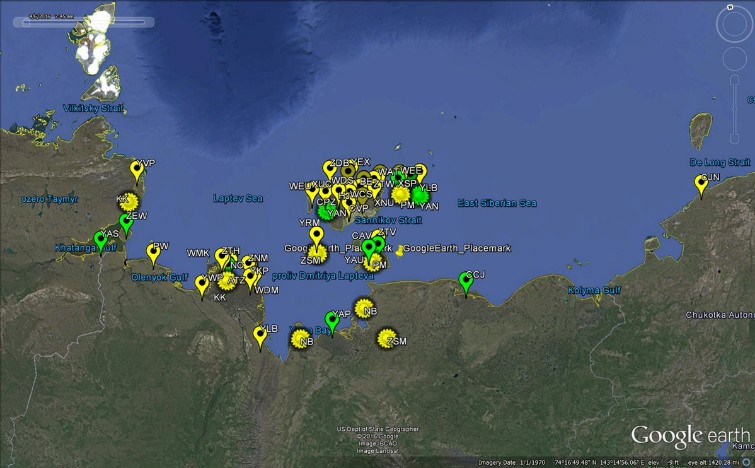

Some of the turnstone have been returning every year and provided some marvellous insights from multiple years worth of data. In spring 2021, Ruddy Turnstone WMA was once again sighted at Newcastle Baths enroute to King Island. This is the 7th consecutive year it has been sighted at this (or nearby) location. It has been captured on King Island 3 times and observed on an additional occasion.

The VWSG Ruddy Turnstone geolocator project is ongoing. This work is done in collaboration with Deakin University and Professor Marcel Klaassen. We are particularly grateful to local volunteers from King Island.
For more details about our work on Ruddy Turnstones, please refer to the following reports/publications.
Minton, C., Gosbell, K., Johns, P., Christie, M., Fox, J.W. & Afanasyev, V. 2010.Initial results from light level geolocator trials on Ruddy Turnstone Arenaria interpres reveal unexpected migration route. Wader Study Group Bull. 117 (1).
Minton, C., Gosbell, K., Johns, P., Christie, M., Klaassen, M., Hassell, C., Boyle, A., Jessop, R., Fox, J., 2011. Geolocator studies on Ruddy Turnstones Arenaria interpres and Greater Sandplovers Charadrius leschenaultii in the East Asian-Australasia Flyway reveal widely different migration strategies. Wader Study Group Bulletin 118, 87-96.
Minton, C., Gosbell, K., Johns, P., Christie, M., Klaassen, M., Hassell, C., Boyle, A., Jessop, R., Fox, J., 2013. New insights from geolocators deployed on waders in Australia. Wader Study Group Bulletin 120, 37-46.
Gosbell, K., C. Minton & J. Fox. 2013 Geolocators reveal incubation and re-nesting characteristics of Ruddy Turnstones Arenaria interpres and Eastern Curlews Numenius madagascarensis. Wader Study Group Bull. 119 (3).
Ken Gosbell, Simeon Lisovski, Clive Minton. Geolocators track Ruddy Turnstone to Newcastle en route to King Island (Tasmania). The Whistler, HBOC:12, 16-21
